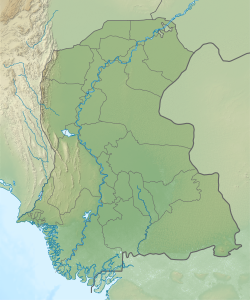 | |
| Location | Sindh, Pakistan |
|---|---|
| Coordinates | 25°32′44″N 69°00′31″E / 25.545650°N 69.008640°E |
| Type | Stupa |
| History | |
| Founded | Early 5th century CE |
| Cultures | Western Satraps Gupta Empire |
Kahu-Jo-Darro, also known as Mirpur Khas stupa, is an ancient Buddhist stupa found at the Mirpurkhas archaeological site in Sindh, Pakistan. The site is spread over 30 acres (120,000 m2). Excavations completed before 1910 revealed this large brick-based stupa and numerous terracotta reliefs now displayed in major world museums.[1][2] The Mirpur Khas site is notable because historic Indian and Arab coins were found during its excavation. This has led scholars such as Derryl MacLean to suggest that Buddhism was thriving in Sindh region around the 10th-century and became extinct in these parts of the west and northwest South Asia after the Islamic conquest.[3]
Early estimates placed the site in the 4th to 5th-century. The stupa is now dated between the 5th to early 6th-century, because its artwork is more complex and resembles those found in the dated sites such as the Ajanta and Bhitargaon in India.[2][4] The terracotta discoveries here include intricately and elegantly carved Buddha images as well as several Hindu artworks such as of Brahma.[5] These different terracotta artwork found here have been variously dated between the 6th- to 10th-century, and include the notable 7th-century painted image of Avalokitesvara Padmapani.[6] The artwork is similar to those seen at Sarnath and at Mathura. Clay tablets containing the Buddhist formula "Ye Dharma Hetu" in 7th-8th century script were also found.[7]
General John Jacob, the acting British Commissioner in Sindh was first to be attracted to the site in the 19th century. His excavations found a vase of fine earthenware containing some pieces of crystal and amethyst, which was sent to the Karachi Museum.[8] The stupa was decorated using terracotta sculptures representing the Buddha.[9]
According to Henry Cousens, the Kahujodaro site was significantly damaged when railway contractors in colonial era Sindh carted off large quantities of the ancient bricks to use them as track ballast.[10] The Kahu-Jo-Daro site was occupied by local villagers through the early 2000s, when the Pakistani government relocated the residents out of the complex to another site.[11] The stupa's condition has further deteriorated, as the practice of stealing the bricks for local construction has furthered the destruction.[12]
The Prince of Wales Museum describes the style of Mirpur Khas stupa as a conflation of the Greco-Buddhist art of Gandhara, and Gupta art:
"The terracotta figures of Mirpur Khas represent the Gupta idiom as it flourished in Sindh. (...) In the terracottas of Mirpur Khas, of which the Museum has a most representative collection, one may see the synthesis of Gandhara and Gupta traditions . Here the old sacrosanct forms of Gandhara are moulded in the Gupta character of nobility , restraint and spirituality and the result is very pleasing. The figures of the Buddha from Mirpur Khas show transformation from the Gandhara to Gupta idiom , which the figures of the donor and Kubera show well developed Gupta types."
— Prince of Wales Museum of Western India[13]
-
The Stupa, before and after excavation
-
Buddhist stupa of Mirpur Khas
-
Buddhist stupa of Mirpur Khas (artist's reconstruction)
-
Floor plan of the Buddhist Stupa, Mirpur Khas
-
Buddha, Mirpur Khas, circa 410 CE
-
Devotee statue.
- ^ Harle, James C. The Art and Architecture of the Indian Subcontinent. Yale University Press. p. 117. ISBN 978-0-300-06217-5.
- ^ a b Relief Panel: 5th century - 6th Century from Mirpur Khas Pakistan, Victoria & Albert Museum, UK
- ^ MacLean, Derryl N. (1989). Religion and Society in Arab Sind. E.J. Brill. pp. 53–60, 71 with footnotes. ISBN 978-90-04-08551-0.
- ^ Schastok, S.L. (1985). The Śāmalājī Sculptures and 6th Century Art in Western India. Brill. pp. 30–31. ISBN 978-90-04-06941-1.
- ^ MacLean, Derryl N. (1989). Religion and Society in Arab Sind. E.J. Brill. pp. 7–20 with footnotes. ISBN 978-90-04-08551-0.
- ^ MacLean, Derryl N. (1989). Religion and Society in Arab Sind. E.J. Brill. pp. 113 with footnote 68. ISBN 978-90-04-08551-0.
- ^ The Indian Historical Quarterly - Volumes 32-33, 1956, Page 182
- ^ Revised lists of antiquarian remains in the Bombay Presidency: and the native states of Baroda, Palanpur, Radhanpur, Kathiawad, Kachh, Kolhapur, and the southern Maratha minor states, Volume 16 of [Reports]: New imperial series, Archaeological Survey of India, James Burgess, Henry Cousens, Printed at the Government central press, 1897, p. 215
- ^ Vakataka - Gupta Age Circa 200-550 A.D, edited by Ramesh Chandra Majumdar, Anant Sadashiv Altekar, Motilal Banarsidass Publ., 1967, p. 435
- ^ Van Lohuizen-De Leeuw, J.E. (1979). South Asian Archaeology 1975: Papers from the Third International Conference of the Association of South Asian Archaeologists in Western Europe Held in Paris. Asian Studies. Brill. p. 153. ISBN 978-90-04-05996-2.
- ^ MIRPURKHAS: Kahu Jo Daro affectees complain of harassment, The Dawn (Nov 20, 2007)
- ^ Sindh, Past, Present and Future, Fahmåidah Husain, University of Karachi. Shāha ʻAbdullat̤īfu Bhiṭāʼī Caʼir, University of Sind. Institute of Sindology, Shah Abdul Latif Bhitai Chair, University of Karachi, 2006, p. 230
- ^ Indian Art. Prince of Wales Museum of Western India. pp. 2–4.








